Mughal India: Art, Culture and Empire, British Library | reviews, news & interviews
Mughal India: Art, Culture and Empire, British Library
Mughal India: Art, Culture and Empire, British Library
A sumptuous treasure trove of illuminated manuscripts covers three centuries of Indian history and culture
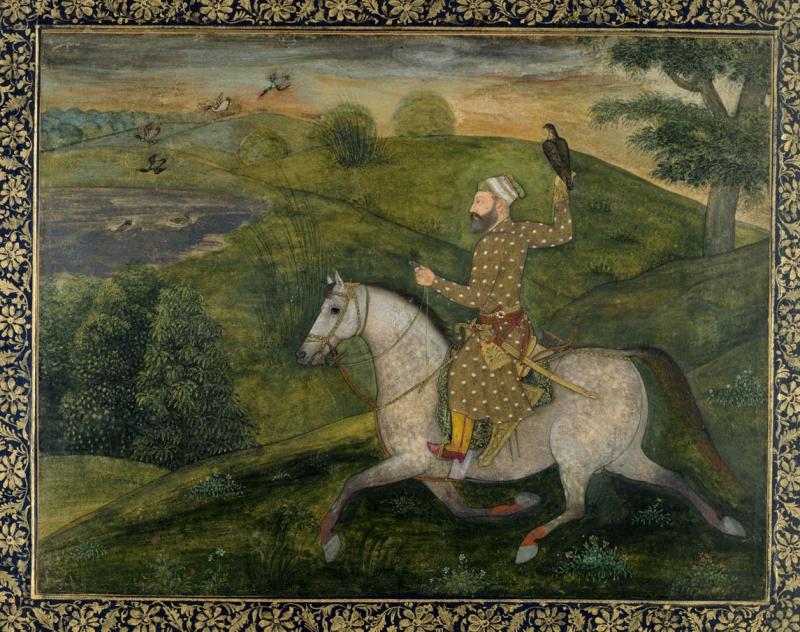
A photograph from 1858 shows a feeble and frail octogenarian who happens to be the last Mughal emperor. Bahadur Shah II (pictured below right), reclining in his wretched prison in Delhi, awaiting trial, is about to be exiled to Burma. Many of his family and his retinue would be summarily executed, the civilian population murdered, and a number of the great Mughal monuments of Old Delhi ruined.
That dynasty is celebrated in this treasure trove of an exhibition, featuring illustrated manuscripts from the three-plus centuries– 1526-1858 – of the Mughal emperors’ reign. Here are leaves from albums of histories, portraits, narratives, poems, biographies, epics, cookbooks, domestic manuals, as well as paintings of palaces, cities and villages, painted parades of fantastical and opulent durbars, and a 15-foot panorama of Delhi as the city was in 1846. There are also several Korans. Objects indicating the grandeur of the Mughal’s material wealth include a Mughal crown (see gallery overleaf), a giant jade tortoise, a suit of 17th-century Mughal armour and a jewelled flywhisk.
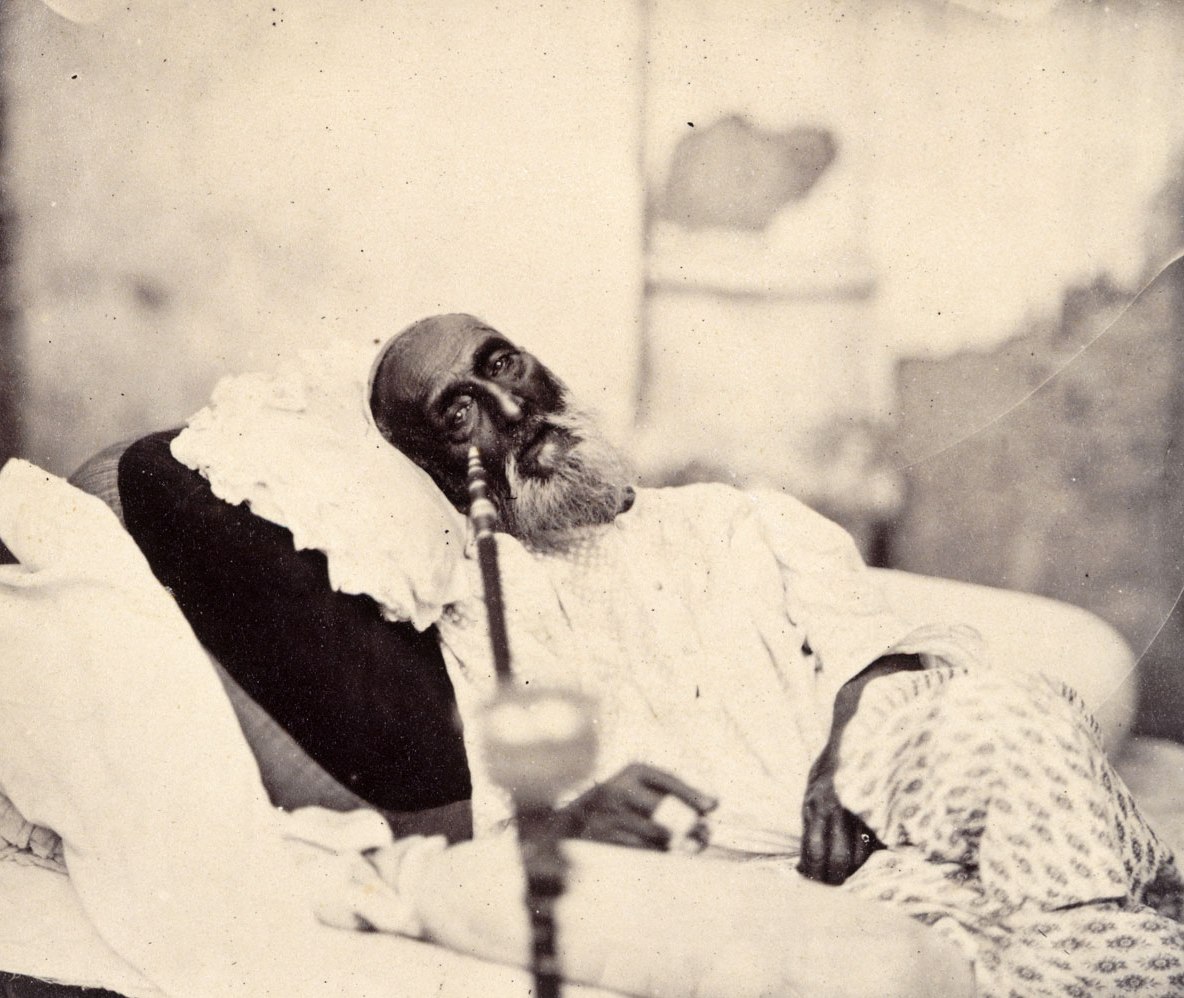 By the beginning of the 18th century Aurangzeb, the sixth Emperor, ruled over probably one fourth of the world’s population: 150 million people. After this apotheosis, the empire declined, the Mughals were confined to ever more ceremonial roles while the East India Company and then the British ruled, until the final catastrophe extinguished the dynasty. What is left is a magnificent array of art, Persian miniatures in bejewelled colours, commemorating and recording life at court, battles, the hunt, flora and fauna, and endless portraits of courtiers, aristocrats, mistresses, wives and the emperors themselves.
By the beginning of the 18th century Aurangzeb, the sixth Emperor, ruled over probably one fourth of the world’s population: 150 million people. After this apotheosis, the empire declined, the Mughals were confined to ever more ceremonial roles while the East India Company and then the British ruled, until the final catastrophe extinguished the dynasty. What is left is a magnificent array of art, Persian miniatures in bejewelled colours, commemorating and recording life at court, battles, the hunt, flora and fauna, and endless portraits of courtiers, aristocrats, mistresses, wives and the emperors themselves.
The Mughals came from Central Asia, via Afghanistan, and were proud to claim descent from Genghis Khan and Timur the Lame, aka Tamerlane; they were in varying degrees fervent admirers of Persian culture, much of which they imported to their Indian dominions. Under the first emperor Babur, Persian became the spoken and written language of choice, and practically all the Mughals were united in their admiration of Persian culture, not to mention gardens and building styles.
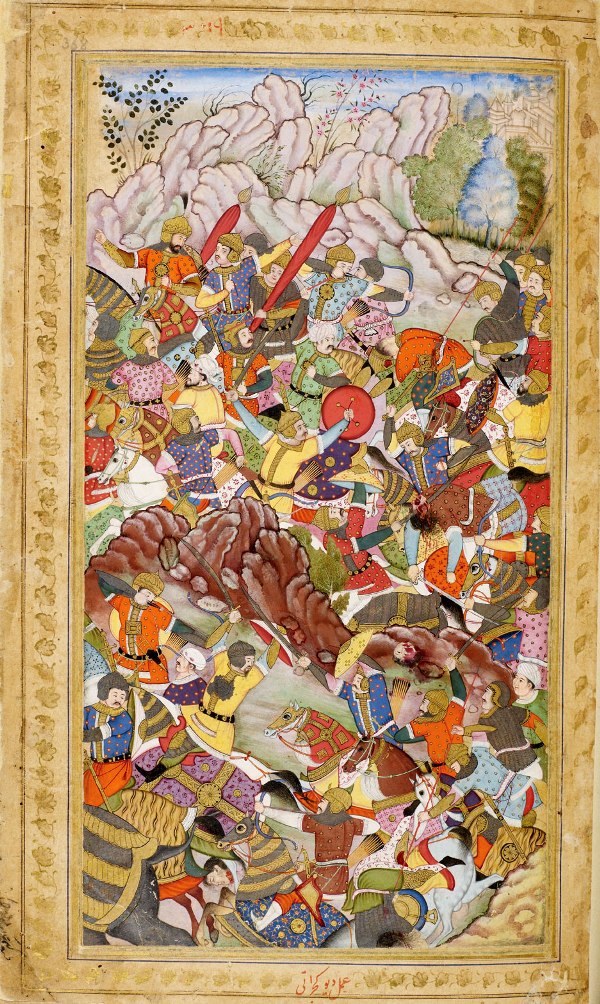 Their personal history was marked by continual strife, addiction to opium and alcohol, and general family chaos as the imperial succession was fought over. The fifth Emperor Shah Jehan, the builder of the Taj Mahal, was incarcerated for the last eight years of his life by his successor, his second son Aurangzeb. He could look out from his prison at the great building which commemorated his love for his wife Mumtaz Mahal, who died after giving birth to their 14th child.
Their personal history was marked by continual strife, addiction to opium and alcohol, and general family chaos as the imperial succession was fought over. The fifth Emperor Shah Jehan, the builder of the Taj Mahal, was incarcerated for the last eight years of his life by his successor, his second son Aurangzeb. He could look out from his prison at the great building which commemorated his love for his wife Mumtaz Mahal, who died after giving birth to their 14th child.
Much of this show features the Indian equivalent of our own illuminated manuscripts, distinguished by the beautifully cursive varieties of Arab script, and illustrated by teams of court artists many imported from Iran and of diverse backgrounds - Muslim and even Hindu. The number of craftsmen and artists expanded exponentially during the long reign of Akbar, the illiterate emperor who loved stories, amassed a library of 24,000 volumes and commissioned a huge number of paintings; he declared that he could not tolerate those who made the slightest criticism of art. “A painter is better than most in gaining a knowledge of God,” he declared, for although the artist can draw and depict, he understands that it is only the divine that can bring life. The Muslim Akbar was highly unusual in not only devising eclectic religious practices for himself but in tolerating all, from Jain to Hindu, Parsee to Christian.
See Mughal India gallery overleaf
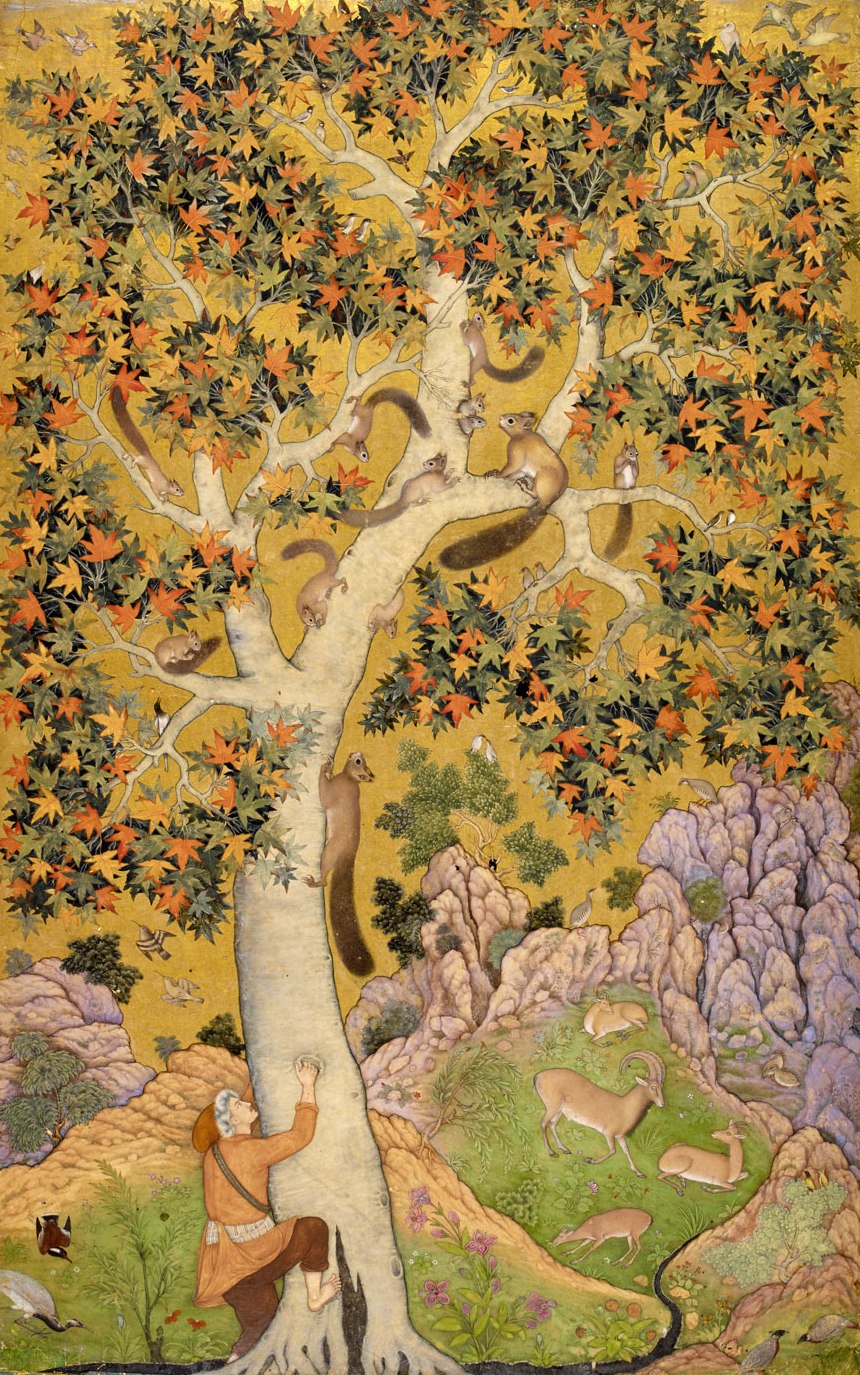 Akbar commissioned the illustrations for various manuscripts of a Persian translation of the autobiography of his grandfather Babur, who in colourful and complex array hunts deer and fights battles (pictured on previous page, Battle of Panipat). Akbar also ordered his own history to be written: we see the infant Akbar being placed into the arms of one of the grandly born ladies of the harem who acted as wet nurses; one of the most vivid illustrations of his life shows Akbar’s vision in which he gave up hunting and ordered all the terrified animals to be freed. It was just as important to follow the genealogy of the emperor, so this same manuscript shows Babur, Akbar’s grandfather, making his son Humayun his successor. A host of men richly robed but all wearing white turbans are witness to the passing of the succession; all takes place in a gorgeous pavilion, its floor a vividly flowered carpet, and a host of drummers punctuates the proceedings.
Akbar commissioned the illustrations for various manuscripts of a Persian translation of the autobiography of his grandfather Babur, who in colourful and complex array hunts deer and fights battles (pictured on previous page, Battle of Panipat). Akbar also ordered his own history to be written: we see the infant Akbar being placed into the arms of one of the grandly born ladies of the harem who acted as wet nurses; one of the most vivid illustrations of his life shows Akbar’s vision in which he gave up hunting and ordered all the terrified animals to be freed. It was just as important to follow the genealogy of the emperor, so this same manuscript shows Babur, Akbar’s grandfather, making his son Humayun his successor. A host of men richly robed but all wearing white turbans are witness to the passing of the succession; all takes place in a gorgeous pavilion, its floor a vividly flowered carpet, and a host of drummers punctuates the proceedings.
A page from an album compiled in Jahangir’s reign – Akbar’s successor – featuring squirrels, rocks, flowers, goats and birds (pictured above right) suggest that there was as much detailed observation of nature as meticulous rendering of historic events, portraits of courtiers and rulers, or epic encounters between fictional characters.
This rare anthology brings into the light a selection from the fabulous collections of the British Library, culled from the Old India Office and the British Museum: it affords a glimpse, however fragmented, into the fabled life of the Mughal courts and through several hundred artifacts, and makes their history visible.
- Mughal India: Art, Culture and Empire at the British Library until 2 April 2013
Click on the gallery images to enlarge
Explore topics
Share this article
The future of Arts Journalism
You can stop theartsdesk.com closing!
We urgently need financing to survive. Our fundraising drive has thus far raised £49,000 but we need to reach £100,000 or we will be forced to close. Please contribute here: https://gofund.me/c3f6033d
And if you can forward this information to anyone who might assist, we’d be grateful.

Subscribe to theartsdesk.com
Thank you for continuing to read our work on theartsdesk.com. For unlimited access to every article in its entirety, including our archive of more than 15,000 pieces, we're asking for £5 per month or £40 per year. We feel it's a very good deal, and hope you do too.
To take a subscription now simply click here.
And if you're looking for that extra gift for a friend or family member, why not treat them to a theartsdesk.com gift subscription?
more Visual arts
 'We are bowled over!' Thank you for your messages of love and support
Much-appreciated words of commendation from readers and the cultural community
'We are bowled over!' Thank you for your messages of love and support
Much-appreciated words of commendation from readers and the cultural community
![SEX MONEY RACE RELIGION [2016] by Gilbert and George. Installation shot of Gilbert & George 21ST CENTURY PICTURES Hayward Gallery](https://theartsdesk.com/sites/default/files/styles/thumbnail/public/mastimages/Gilbert%20%26%20George_%2021ST%20CENTURY%20PICTURES.%20SEX%20MONEY%20RACE%20RELIGION%20%5B2016%5D.%20Photo_%20Mark%20Blower.%20Courtesy%20of%20the%20Gilbert%20%26%20George%20and%20the%20Hayward%20Gallery._0.jpg?itok=7tVsLyR-) Gilbert & George, 21st Century Pictures, Hayward Gallery review - brash, bright and not so beautiful
The couple's coloured photomontages shout louder than ever, causing sensory overload
Gilbert & George, 21st Century Pictures, Hayward Gallery review - brash, bright and not so beautiful
The couple's coloured photomontages shout louder than ever, causing sensory overload
 Lee Miller, Tate Britain review - an extraordinary career that remains an enigma
Fashion photographer, artist or war reporter; will the real Lee Miller please step forward?
Lee Miller, Tate Britain review - an extraordinary career that remains an enigma
Fashion photographer, artist or war reporter; will the real Lee Miller please step forward?
 Kerry James Marshall: The Histories, Royal Academy review - a triumphant celebration of blackness
Room after room of glorious paintings
Kerry James Marshall: The Histories, Royal Academy review - a triumphant celebration of blackness
Room after room of glorious paintings
 Folkestone Triennial 2025 - landscape, seascape, art lovers' escape
Locally rooted festival brings home many but not all global concerns
Folkestone Triennial 2025 - landscape, seascape, art lovers' escape
Locally rooted festival brings home many but not all global concerns
 Sir Brian Clarke (1953-2025) - a personal tribute
Remembering an artist with a gift for the transcendent
Sir Brian Clarke (1953-2025) - a personal tribute
Remembering an artist with a gift for the transcendent
 Emily Kam Kngwarray, Tate Modern review - glimpses of another world
Pictures that are an affirmation of belonging
Emily Kam Kngwarray, Tate Modern review - glimpses of another world
Pictures that are an affirmation of belonging
 Kiefer / Van Gogh, Royal Academy review - a pairing of opposites
Small scale intensity meets large scale melodrama
Kiefer / Van Gogh, Royal Academy review - a pairing of opposites
Small scale intensity meets large scale melodrama
 Jenny Saville: The Anatomy of Painting, National Portrait Gallery review - a protégé losing her way
A brilliant painter in search of a worthwhile subject
Jenny Saville: The Anatomy of Painting, National Portrait Gallery review - a protégé losing her way
A brilliant painter in search of a worthwhile subject
 Abstract Erotic, Courtauld Gallery review - sculpture that is sensuous, funny and subversive
Testing the boundaries of good taste, and winning
Abstract Erotic, Courtauld Gallery review - sculpture that is sensuous, funny and subversive
Testing the boundaries of good taste, and winning
 Edward Burra, Tate Britain review - watercolour made mainstream
Social satire with a nasty bite
Edward Burra, Tate Britain review - watercolour made mainstream
Social satire with a nasty bite
 Ithell Colquhoun, Tate Britain review - revelations of a weird and wonderful world
Emanations from the unconscious
Ithell Colquhoun, Tate Britain review - revelations of a weird and wonderful world
Emanations from the unconscious

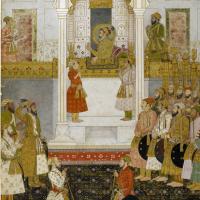



Add comment